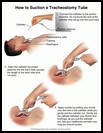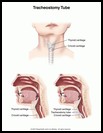
Tracheostomy Care: Humidifying and Suctioning
Why is humidifying and suctioning important?
When you breathe through your mouth and nose, air is naturally warmed, moistened, and cleaned. Air coming in through a tracheostomy (trach) tube does not get moistened and cleaned. When this cool, dry air comes into the tube, it causes the lungs to make more mucus. These thick mucus secretions can block the trach tube and make it hard for your child to breathe.
Dry air may cause your child's secretions to become thick and hard to cough up. Make sure your child gets the right amount of humidity. You will also need to suction to clear secretions. These actions will make it less likely that the tube will become blocked. Blockages can be very dangerous and stressful. Work with your healthcare provider to learn how to manage your child's tracheostomy care and allow your child to have a normal, active life.
HUMIDIFICATION
Humidification is very important for thinning secretions so they do not block the trach tube. Humidification is needed even in very damp climates, at least at first. Humidity in the lungs helps to protect the lining of the lung and keep secretions thin.
How do I keep the air humidified?
Air is humidified using a humidifier or an HME (heat moisture exchanger) at different times during the day. The humidifier is used at night and periodically during the day. The HME (heat moisture exchanger) is a device that your child can wear during the day to help keep the air moist without having to be hooked up to the humidifier.
Before your child is discharged from the hospital, your discharge planner or instructor should make arrangements with a medical supply company to get a humidifier, HME, and any other equipment you will need.
Humidifier: Several different types of humidifiers are available. They all have a water reservoir, a connecting hose, and a collar that fastens around your child's neck. The trach collar keeps a pocket of moist air at the opening of the trach tube. This type of humidifier should be used at night and periodically during the day.
Either your discharge instructor or the equipment supplier will teach you to use and clean the humidifier and how to order supplies. Usually, you will need to clean and disinfect the humidifier at least once a week, according to the supplier's instructions.
The thickness of the secretions as well as changes in your child's breathing rate and pattern will help you decide if your child needs to stay on the humidifier during the day. Faster breathing, a heavy cough and thicker secretions mean your child needs to use the humidifier. If these are not present, your child is probably ready for the HME and normal activity.
HME (Heat Moisture Exchanger): An HME is a humidifying filter that fits onto the end of the trach tube. HMEs are also known as artificial noses, filters, or T-pieces. They come in several shapes and styles. The filter may be made of gauze, foam, or a special paper. As your child breathes out, the HME collects warmth and moisture. When your child breathes in, the air is warmed and humidified. Children should wear an HME when they are awake and active and want to be free from humidifying equipment.
Use the HME when your child is awake and active. Then, use the humidifier during naps, meals, and at night to replenish the lost moisture in the lungs. Usually, a child with a new tracheostomy can start out wearing an HME for at least 1 hour at a time 2 or 3 times a day. As long as the secretions do not get too thick and your child seems to handle the HME well, he can start wearing the HME for a longer amount of time. Even after a short break using the humidifier, your child will be ready to use the HME again and lead an active life.
Disposable HMEs are meant for a single use. They should be thrown away when clogged with mucus. If too much mucus is a problem, a reusable HME (a plastic T-piece with replaceable gauze) is a less expensive option. The plastic T-piece can be washed and disinfected many times, but the disposable HMEs cannot. You may find it helpful to use both types. For example, use a T-piece with gauze in the morning (until the amount of secretions goes down) and then use a disposable HME in the afternoon.
If the child has been using the device for a long period of time, or if it is hot and dry or windy, add a few drops of saline to the gauze to replace the lost moisture. You can buy saline drops at your local drug store or pharmacy. If your child is drinking plenty of fluids and has been using the humidifier, you will not need to moisten the gauze in the HME.
The best way to judge how long your child can use an HME is to periodically suction the trach.
- If the secretions easily pass through the catheter, your child can wear the HME for a longer period of time.
- If secretions are sluggish through the catheter, your child may need to add a few drops of saline to the trach or the HME to replace the evaporated moisture.
- If secretions coat the outside of the catheter or clog it, your child may need to use the humidifier for at least 1/2 to 1 hour or need several drops of saline into put into the trach tube, followed by suctioning until the secretions thin out.
Remember to:
- Check the HME gauze to be sure it doesn't get covered over with secretions.
- Have your child drink plenty of fluid each day. Taking in plenty of fluid will help keep secretions thin.
Check with your specialist if you have questions about humidification or HMEs.
SUCTIONING
Suctioning is important to keep mucus from blocking the trach tube. It helps your child clear secretions and breathe easier.
When do I suction the tube?
Suctioning should be done whenever it is needed. Signs that your child needs suctioning include:
- gurgling or bubbly sounds
- coughing
- trouble breathing or very fast breathing.
Suctioning should also be done at the following set times:
- before eating (waiting until after eating may lead to vomiting)
- before and after sleeping (including naps).
How often your child needs to be suctioned depends on the child's age, how much mucus is produced, and how well the child is breathing. A baby or toddler may need to be suctioned more often because of crying, a less efficient cough, and more frequent colds. An older child may need suctioning only occasionally when they are healthy and more often when he or she is sick. The best advice, especially for babies, is to first attend to what is making them upset, calm them, and then decide if they need to be suctioned. Frequently, you will find that after your child is quieted, the tube is actually quite clear.
Remember, secretions and saliva are always being produced. This is fluid that the body naturally recycles. If you suction too much, your child may not have a reserve of moisture for longer periods of time wearing the HME.
What equipment is needed?
You will need the following equipment:
- A suction machine with tubing
- A clean catheter (a catheter is a small tube that goes through the trach opening into the airway and removes the secretions). You need to know how long your child's trach tube is to know how much of the catheter you need to insert. Hold the catheter at or just above the suction depth. If the catheter is marked, hold it at 6.5 or 7.0 cm if you are going to suction 6.5 cm. For unmarked catheters, tape a small ruler to your suction machine and have your specialist mark the correct depth in centimeters and inches for you. Your discharge instructor should tell you the length of your child's trach tube and how far to suction before you leave the hospital.
- A rinsing solution of sterile water or saline.
You should also have access to a resuscitation bag in case of unexpected emergencies with the tracheostomy.
How do I suction the tube?
To suction the tube:
- Wash your hands with soap and water and dry them well.
- Pick up the catheter from the end that is attached to the suction machine. Do not pick up the end that will go into the trach tube.
- Connect the catheter to the suction machine tubing and turn on the machine. Be sure you know how far the catheter should go in before you begin suctioning, usually the length of the trach tube plus 1/4 inch. Hold the catheter at or just above the suction depth.
- Gently put the catheter into the trach tube without applying suction. The catheter will follow the curve of the trach tube. Stop the catheter when you reach the premeasured length. Do not use force. If you are unable to pass the catheter the specified depth, the trach tube may have a plug inside it. Add saline and try again to suction. If unsuccessful, change the tube immediately.
- Apply suction by putting your thumb over the hole in the catheter while you gently pull the catheter back out. Gently roll the catheter between your thumb and forefinger as you pull the catheter out.
Do not suction for longer than 5 to 10 seconds at a time. If you suction longer than that, you may block oxygen from getting to your child's lungs.
Normal secretions are clear to white and are thin to slightly thick. If the secretions are very thick, you may need to suction several times. Let your child rest and breathe for at least 30 seconds before repeating suctioning. Put several drops of saline (not plain sterile water) down the trach and suction again. Putting saline solution down the trach and suctioning will likely cause coughing and choking. This is normal and helps to loosen secretions so that your child can cough them out.
NOTE: Expert opinions vary on the use of gloves, saline, and air.
- Gloves: Some experts recommend gloves when you suction, others do not. Gloves help prevent the transfer of germs if you or your child is sick. Ask your healthcare provider if you should wear gloves. Wash your hands carefully before and after suctioning, whether you wear gloves or not.
- Saline drops: Some experts recommend a few drops of saline be put down the trach before you suction the first time. Others recommend suctioning without saline first so you can see what the secretions look like. Some advise making your own saline solution while others recommend buying the saline solution. Ask your healthcare provider what you should do.
- Air: Some experts recommend giving a puff of air with a bag before and after suctioning to get oxygen into the child's lungs while others don't feel this is necessary.
Be sure you understand the steps of suctioning and have practiced it many times before you get home.
How do I clean the suctioning equipment?
Rinse the catheter with sterile water and store it in a commercially made solution (supplied by your equipment company) or a solution of 1 part hydrogen peroxide to 1 part sterile water. Rinse the catheter with sterile water just before using. The catheter suction machine, tubing, and any other parts that have touched the secretions must be cleaned regularly. The equipment supplier will tell you how and when to do this.


